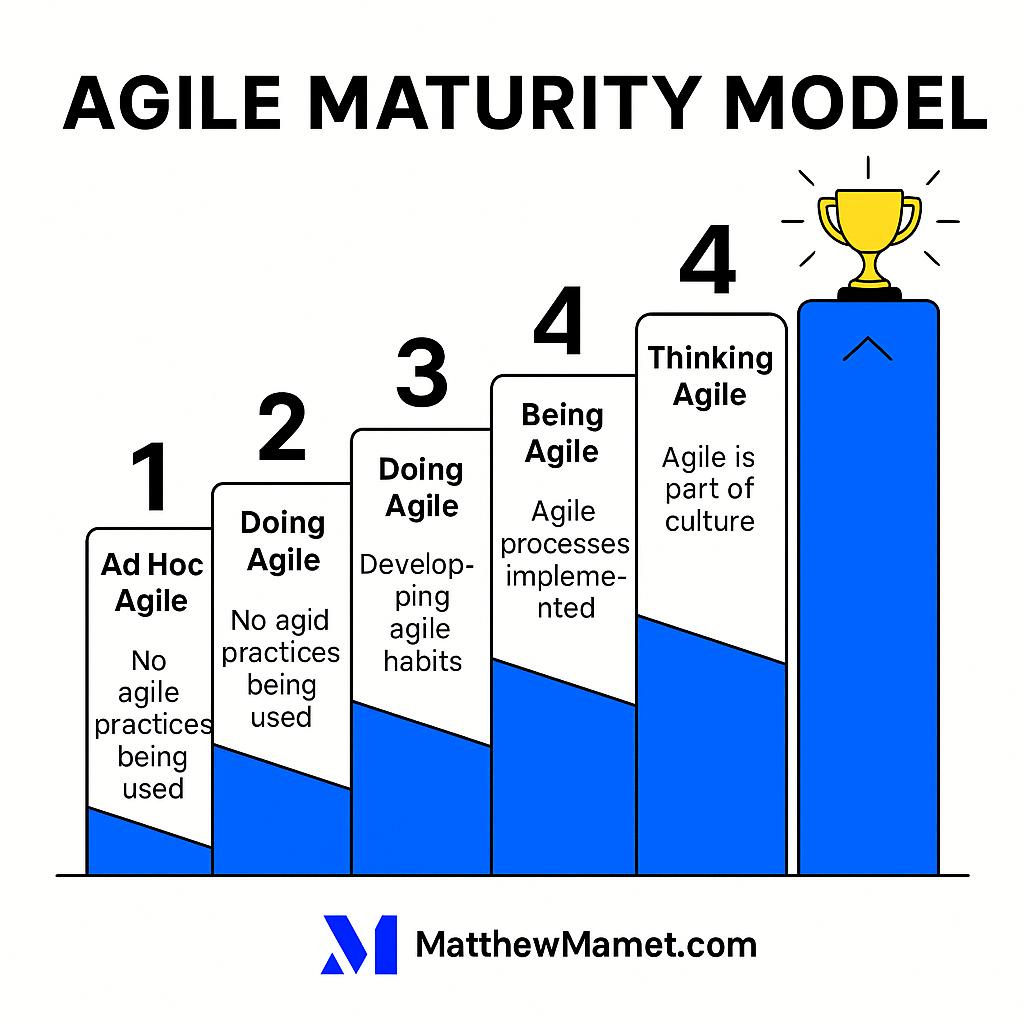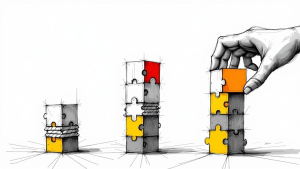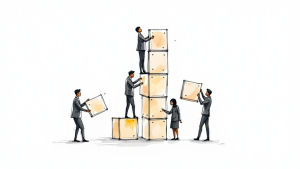Table of Contents
An agile maturity assessment isn't a final exam—it's more like a compass for your team's journey. Think of it as a strategic health check that shows you where you're strong and, just as importantly, where you have real opportunities to grow. It’s the tool that helps you move from simply doing the agile rituals to truly being agile.
Understanding Your Team's Agile Journey
Adopting agile is a bit like learning a new language. At first, you’re just repeating phrases and following the rules—those are your ceremonies and rituals. But real fluency comes when you understand the culture and nuance behind the words. That's maturity.
An agile maturity assessment is how you measure that fluency. It looks past the surface-level stuff and digs into how deeply agile principles are actually woven into your team's mindset, day-to-day behaviors, and, ultimately, the results you deliver.
The goal here isn't to get a grade. It’s to get an honest baseline. The first question is always: Where are we, really? Without that starting point, any effort to improve is just a shot in the dark.
From Process to Performance
It’s easy to fall into the trap of "ceremony-first" agile, where the team is great at stand-ups and retrospectives but isn't connecting those activities to real business value. A good assessment forces a shift in focus from merely following the process to driving actual performance.
Ready to drive more growth & achieve bigger impact?
Leverage my 25+ years of successes and failures to unlock your growth and achieve results you never thought possible.
Get StartedIt pushes you to ask the tougher questions:
- Are our sprints actually delivering something valuable to our customers?
- How fast can we realistically pivot when the market changes?
- Is our team truly empowered to solve problems on their own, or are they waiting for permission?
This shift is everything. While many organizations claim to be agile, how mature they are varies wildly. A recent survey revealed that only 18% of organizations have adopted agile practices across all of their teams. That gap shows just how many companies are still in the early stages of their journey. You can dig into more of these findings in the 2025 State of Agile report from Knowledgehut.
To truly understand performance, assessments look at a few core dimensions. They provide a holistic view of your team's capabilities, from technical skills to customer focus.
Core Dimensions of Agile Maturity
| Dimension | Focus Area | Example Metric |
|---|---|---|
| Team Dynamics & Culture | How well the team collaborates, trusts each other, and embraces agile values like transparency and shared ownership. | Team morale scores, frequency of constructive feedback. |
| Technical Excellence | The quality of engineering practices, including code quality, testing, and continuous integration/delivery (CI/CD). | Cycle time, bug escape rate, deployment frequency. |
| Product & Customer Focus | The team's connection to customer needs and ability to deliver meaningful value with each iteration. | Customer satisfaction scores, feature adoption rates. |
| Process & Flow | The efficiency of the team's workflow, from idea to delivery, and their ability to continuously improve it. | Lead time, work-in-progress (WIP) limits. |
These dimensions help frame the conversation, moving it beyond "Are we doing stand-ups correctly?" to "Are we building the right thing, the right way?"
Sparking Continuous Improvement
Ultimately, the biggest win from an agile maturity assessment is its power to kickstart continuous improvement. It gives you a structured way to have conversations that align everyone—team members, stakeholders, and leaders—around a shared vision for what "better" looks like.
The real power of an assessment isn't the final score; it's the rich, collaborative conversations it sparks. It transforms abstract goals like "be more agile" into a concrete, actionable roadmap for getting there.
Ready to drive more growth & achieve bigger impact?
Leverage my 25+ years of successes and failures to unlock your growth and achieve results you never thought possible.
Get StartedBy pinpointing specific areas for improvement, whether it's in your CI/CD pipeline, team collaboration, or product strategy, the assessment essentially builds your improvement backlog for you. This process is at the very heart of agile software development, embedding learning and adaptation right into your team's DNA. You can find out more about this foundational approach in our guide to agile software development.
This turns what could be a one-off check-in into an ongoing engine for creating a more resilient, effective, and truly agile organization.
Exploring Common Agile Maturity Models
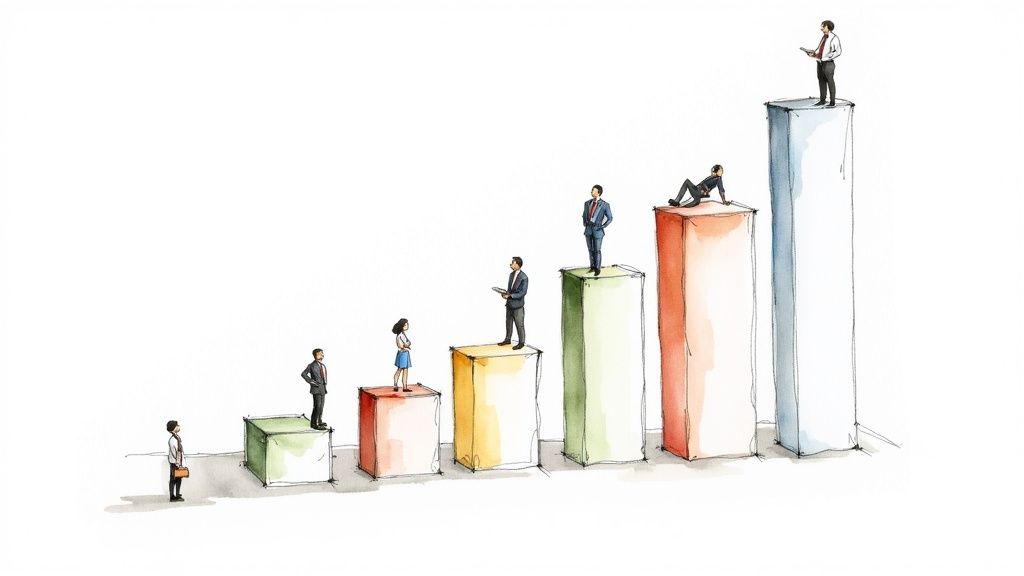
Choosing an agile maturity model is a bit like picking a map for a road trip. A simple hand-drawn map might be all you need for a quick drive across town, but you'll want a full-blown GPS with real-time traffic for a cross-country trek. The same logic applies here. Some models give you a quick directional check, while others provide a deep, layered analysis fit for a large enterprise.
There’s no "best" model out there. The right choice is the one that fits your company's size, your goals, and—most importantly—your culture. It's about finding a framework that asks the right questions for your team and gives you a clear, actionable path forward.
Ready to drive more growth & achieve bigger impact?
Leverage my 25+ years of successes and failures to unlock your growth and achieve results you never thought possible.
Get StartedThe Five-Level Maturity Scale
A classic and widely used approach is the five-level maturity scale. You can think of it like the belt system in martial arts. Each level signifies a deeper mastery of agile principles and practices. The names for each level might change from one version to another, but the underlying progression is almost always the same.
- Level 1 Initial: Things feel chaotic and unpredictable. The team might be using agile buzzwords, but the practices are all over the place.
- Level 2 Managed: The basics are in place. You’re seeing regular stand-ups and retrospectives. The team is following some of the rules, even if they don't fully grasp the "why" behind them yet.
- Level 3 Defined: A standardized agile process is humming along. Everyone gets their role, and there’s a consistent rhythm to sprints and releases.
- Level 4 Measured: The team has started using data to drive decisions. Metrics like cycle time and velocity aren't just vanity numbers; they're used to measure performance and find real opportunities for improvement.
- Level 5 Optimizing: This is the black belt level. Continuous improvement is just part of the team's DNA. They are proactively experimenting, adapting, and fine-tuning their process to deliver the most value possible.
This model is so popular because it’s straightforward. It gives teams a simple, easy-to-understand roadmap to see where they are and what it takes to get to the next stage of their agile maturity assessment.
The Agile Fluency Model
Developed by Diana Larsen and James Shore, the Agile Fluency Model takes a different tack. It's less about climbing a rigid, linear ladder and more about becoming truly fluent in different aspects of delivering value. It's not so much a single path as it is a map with different zones of capability.
The model lays out four distinct zones of fluency:
- Focusing on Value: The team consistently works on what the business actually needs most, aligning their efforts with the big-picture strategy.
- Delivering Value: The team can release their product whenever they need to, without all the usual drama and last-minute bugs. This comes from rock-solid technical practices.
- Optimizing Value: The team isn't just taking orders. They have a deep sense of the market and can make smart product decisions that directly boost business outcomes.
- Optimizing Systems: The team starts looking beyond their own product. They see the bigger picture and work to improve how the entire organization creates and delivers value.
The real insight from the Agile Fluency Model is that there are different "endgames" for agility. Not every team needs to reach the final zone. Success means achieving the level of fluency that best serves what your organization is trying to accomplish.
The widespread adoption of Agile proves why these models are so critical. The latest data shows that a whopping 71% of organizations use Agile for software development, but its influence now reaches far beyond tech. Agile thinking is shaping leadership, marketing, and operations, making a holistic maturity model a must-have for any company that's serious about growth. You can dig into these trends more in the 2025 State of Agile report findings. This explosion in use just underscores the need for effective assessment tools to guide teams as they evolve.
Running Your Own Assessment
So, how do you actually run one of these things? It’s less about being a harsh critic and more about being a great workshop facilitator. Your real job is to create a space where honest, constructive feedback can turn into real, actionable insights. Think of it less as an audit and more as a collaborative planning session for the future.
The entire process boils down to turning data into a meaningful story of improvement. This simple infographic breaks down the core stages.
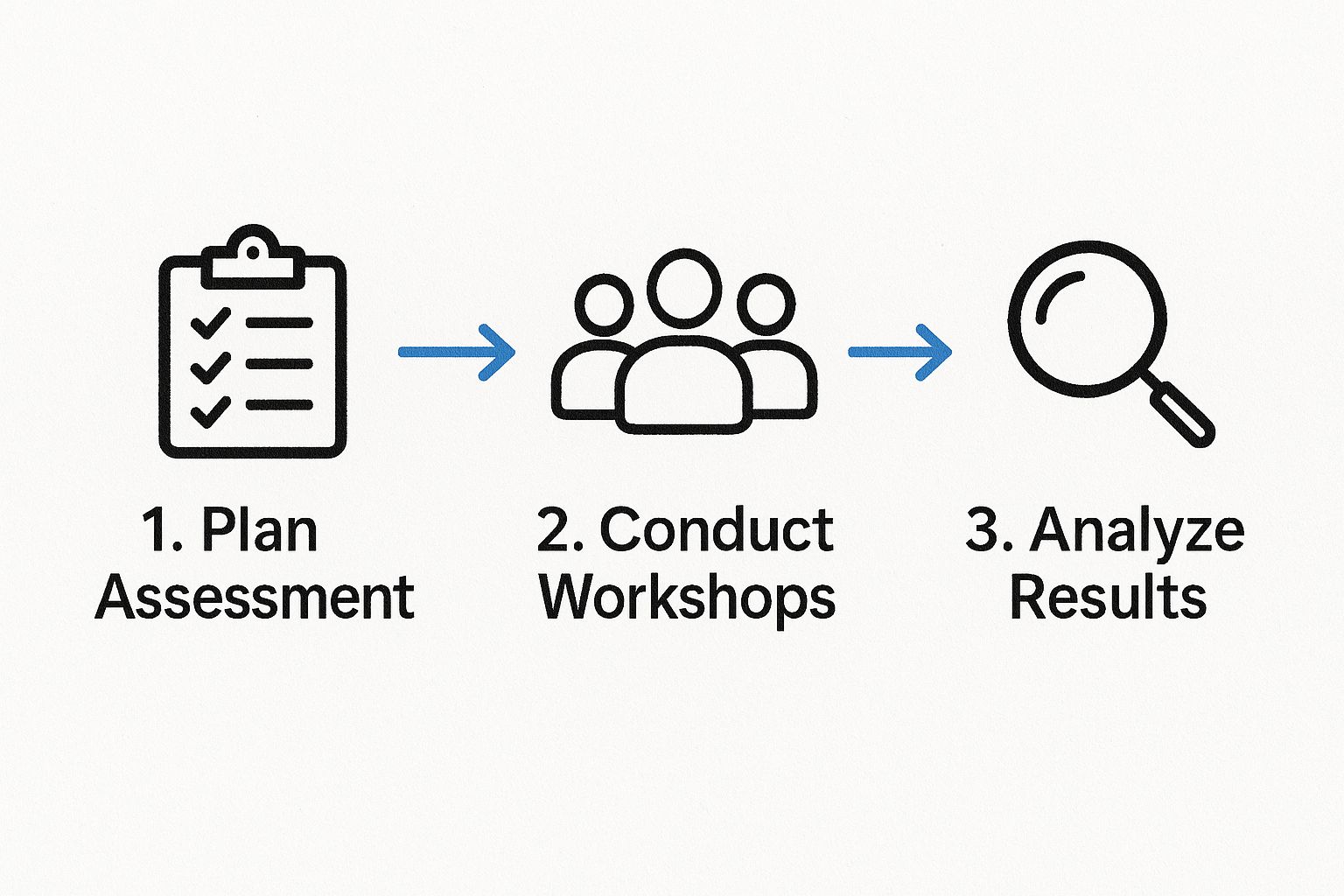
Seeing the journey this way helps everyone get on the same page. It’s a structured process, not just a random feedback free-for-all. Each step builds on the last, leading to clear, purposeful outcomes.
Step 1: Define Your Scope and Goals
Before you even think about sending out a survey, you have to define what success looks like. Get your key stakeholders in a room and ask a few pointed questions to set your direction. Without this, you're just guessing.
- What are we trying to improve? Are you focused on one team, a whole department, or something specific like your CI/CD pipeline? Get granular.
- Which model will we use? Choose a framework that fits your goals. It could be a simple five-level scale or a more nuanced model like Agile Fluency.
- What does "better" actually look like for us? Define your ideal future state. Is it faster delivery? Higher team morale? Better product-market fit?
Answering these questions first prevents the whole thing from becoming a vague, unfocused exercise. It gives you a clear target to aim for.
Ready to drive more growth & achieve bigger impact?
Leverage my 25+ years of successes and failures to unlock your growth and achieve results you never thought possible.
Get StartedStep 2: Gather Honest Data
With your goals set, it's time to collect the data. The trick here is to use a mix of methods to get the full picture. Relying on just one source will leave you with massive blind spots.
The most valuable data from an agile maturity assessment often comes from the qualitative insights gathered in interviews and observation, not just the quantitative scores from a survey. The real gold is in the 'why' behind the numbers.
To get well-rounded data, you'll want to combine a few approaches:
- Surveys: Use your chosen maturity model to build out anonymous surveys. This gives you a broad quantitative baseline and, more importantly, makes it easier for people to share candid feedback without fear of judgment.
- Interviews: Sit down for one-on-one or small-group chats with team members, product owners, and managers. These conversations are where you’ll uncover the context and the stories behind the survey scores.
- Observation: Just show up. Attend team ceremonies like stand-ups, planning sessions, and retrospectives. Watching team dynamics in their natural habitat provides invaluable, unfiltered insights that people might not even think to mention in a survey.
Step 3: Analyze and Create an Action Plan
Once you have all this data, the final step is to turn it into a plan. Resist the urge to fix everything at once. I've seen it a hundred times—it's a common pitfall that leads to overwhelm and, ultimately, inaction.
Instead, facilitate a workshop to review the findings with the team. Work together to identify just one to three high-impact areas to focus on. These become the foundation of your improvement backlog.
For example, if the assessment reveals that requirements are consistently unclear, a great next step is to work on refining your user story and acceptance criteria practices. This is a core competency in effective product management, where that kind of clarity has a direct impact on team velocity and product success.
When you transform raw data into a focused, collaborative action plan, your agile maturity assessment stops being a tool for measurement and becomes a powerful engine for empowerment. It’s how you build a real culture of continuous improvement.
Choosing the Right Agile Assessment Tool
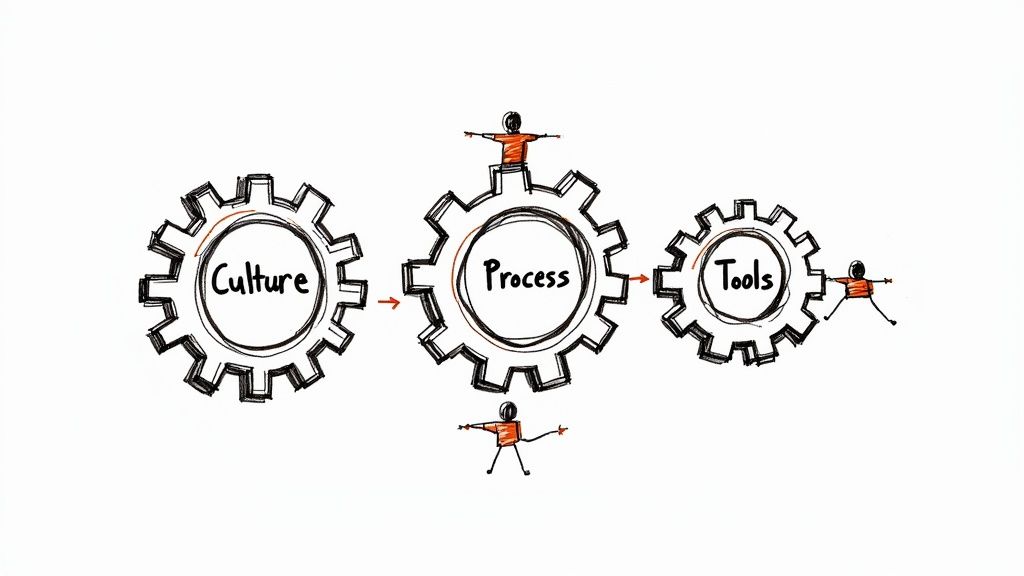
Picking an agile assessment tool feels a lot like choosing the right diagnostic for a health checkup. A stethoscope is great for a quick listen, but you need an MRI for a deep, detailed analysis of what’s really going on under the surface. The best tool for your team isn’t the fanciest or most expensive one; it’s the one that fits your scale, budget, and the kind of insights you actually need to drive real change.
If your team is just starting out, simple templates or lightweight online tools are often more than enough. They can help you get a foundational read on your agile health without drowning you in complex data. Think of them as the perfect conversation starter for establishing a baseline.
But as your organization—and your agile practice—matures, the complexity grows. This is where more specialized, powerful tools become indispensable.
Navigating the Tool Marketplace
The market for these tools is packed, with options designed for nearly every kind of company. In 2024, these tools have become mission-critical for guiding agile transformations. You’ve got platforms like Info-Tech Research Group offering deep analytical power suited for huge enterprises, and then you have tools like Agilebin, which offers a fast voting system perfect for a startup that needs a quick pulse check.
Others, like AgilityHealth Radars, are brilliant at visualizing data across many teams, making patterns and problems jump right off the screen. For organizations committed to the SAFe framework, a specialized option like the Team and Technical Agility (TTA) Assessment is built just for you. Even flexible platforms like Smartsheet offer adaptable templates you can customize. To get a broader view, you can compare more agile maturity assessment tools and see what fits your specific context.
With so many choices, it helps to break them down into categories to figure out where to even begin your search.
Comparison of Agile Maturity Assessment Tools
Deciding on a tool often comes down to a simple trade-off: do you need something quick and easy, or something deep and comprehensive? This table breaks down the main categories to help you match a tool to your team's reality.
| Tool Category | Ideal For | Key Feature | Example(s) |
|---|---|---|---|
| Simple Templates & Checklists | Small teams or startups | Low cost and incredibly easy to start | Excel/Google Sheets templates, Agilebin |
| Visual Radar Tools | Organizations with multiple teams | Rich, easy-to-digest data visualization | AgilityHealth Radars |
| Enterprise Platforms | Large, complex organizations | Deep, portfolio-level analysis and tracking | Info-Tech, SAFe TTA Assessment |
Ultimately, finding the right tool is about finding the right fit for your organization’s unique context. What works wonders for a 10-person startup will be completely inadequate for a 500-person engineering department.
The right tool doesn't just give you a score; it tells you a story. It should highlight not just where you are, but also what your most logical next steps should be.
Carefully matching the tool to your needs is what turns an agile assessment from just another report that gathers dust into a genuine catalyst for growth.
Turning Assessment Results Into Action
An agile maturity assessment report isn't a trophy to polish and put on a shelf. It’s a living document—a backlog of high-value improvement opportunities. The real work begins after the scores are tallied and the charts are made. This is where you transform raw data into real forward momentum for your team.
The first step is always open communication. Share the findings broadly and honestly, framing them not as a report card but as a shared map showing where you are and where you could go. This act of sharing is foundational. The best agile teams are built on a culture of openness, and you can learn more about how agile transparency empowers teams in our dedicated guide.
With the results in hand, fight the urge to fix everything at once. That's a classic failure pattern that leads straight to burnout and analysis paralysis. Instead, get together with your team and identify just one to three high-impact focus areas.
From Insight to Experiment
Once you have your focus areas, the next step is to brainstorm small, testable improvements. The key here is to think like a scientist running an experiment, not an engineer building a bridge. You're looking for quick, low-risk changes you can weave directly into your existing work cycles.
A great way to structure this is by creating specific "improvement stories" for your backlog. These aren't massive projects, just small, focused tasks.
- If the problem is: "Our user stories are consistently vague and lead to rework."
- A good experiment is: "For the next two sprints, we'll make sure every story has at least three clear acceptance criteria before it's considered 'ready'."
- If the problem is: "Our daily stand-ups feel more like status reports than collaborative planning."
- A good experiment is: "For one week, we'll structure our stand-up around the three questions, focusing only on blockers and how we can help each other today."
Integrating Improvement Into Your Rhythm
These small experiments shouldn't live outside your normal workflow. They should become part of your sprints or iterations, just like any other piece of work. This approach has a powerful effect.
The goal is to make continuous improvement a natural habit, not a special event. By embedding small experiments into your sprints, you transform the agile maturity assessment from a one-time audit into a recurring catalyst for growth.
This process ensures improvement isn’t an afterthought but a core part of how the team operates. By treating the assessment findings as a backlog, you empower the team to own their own growth. They become a self-improving unit, actively steering their journey toward greater agility and effectiveness, one small, intentional step at a time. This is how a truly agile team is built.
Common Questions About Agile Assessments
Once you start digging into agile maturity, a few questions always seem to pop up. It's natural. Let's tackle the most common ones so your team can move forward with clarity, not confusion.
How Often Should We Run an Assessment?
The sweet spot for most teams is a full-scale assessment every 6 to 12 months. This gives you enough runway to actually implement changes from the last review and see if they're making a real difference.
But you don't have to wait that long for a check-in. I've seen a lot of great teams run lighter "pulse checks" more often, maybe once a quarter. These are perfect for tracking progress on a specific improvement goal you flagged in the big assessment.
Can a Team Run an Assessment Themselves?
Absolutely. In fact, when a team runs its own assessment, it can be incredibly powerful. It builds a sense of ownership that you just can't get any other way. The team starts driving its own growth.
The trick is to have a neutral facilitator. This could be your Scrum Master, an agile coach, or even a volunteer from a different team. Their job is to keep the process unbiased, make sure everyone feels safe enough to be honest, and ensure every voice is heard without judgment.
Ready to drive more growth & achieve bigger impact?
Leverage my 25+ years of successes and failures to unlock your growth and achieve results you never thought possible.
Get StartedAn agile maturity assessment isn't about chasing a perfect score. It's about building a perfect-able process. The real goal is to foster a culture of continuous improvement, where the team is always looking for that next small step forward.
What’s the Difference Between an Assessment and a Retrospective?
This is a great question, and it's all about scope and timeline.
A retrospective is tactical. It zooms in on a single sprint or iteration, looking for small, immediate tweaks the team can make for the very next sprint. It's short-term and focused.
An agile maturity assessment, on the other hand, zooms out. It takes a much broader, more strategic look at the team's capabilities, culture, and processes over a longer period. It’s about spotting the systemic patterns and uncovering those bigger opportunities for real, lasting growth.
Guiding your team through this isn't just about process; it's about leadership. Matthew Mamet offers specialized growth coaching for software and product executives who want to build high-performing, self-improving teams. To sharpen your own strategy and help your team reach its potential, you can explore personalized coaching.
Ready to drive more growth & achieve bigger impact?
Leverage my 25+ years of successes and failures to unlock your growth and achieve results you never thought possible.
Get Started

